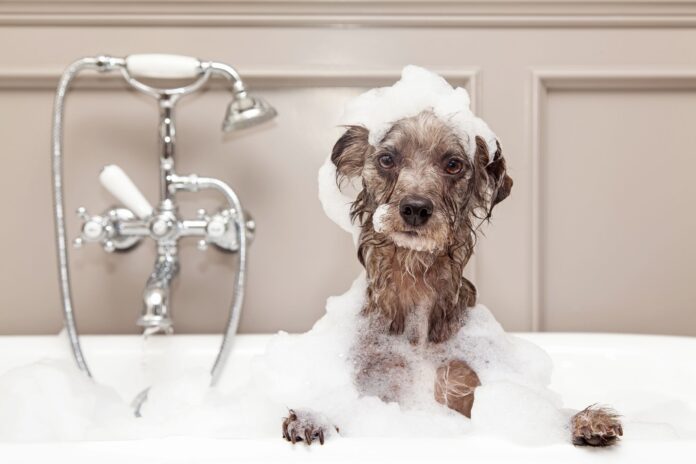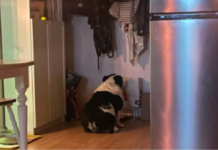Last Updated on August 21, 2023 by Fumipets
6 Pet Shower Pro Tips For Dog Owners
Bathing your beloved canine companion can be a joyful bonding experience or a challenging endeavor, depending on your approach. Pet showering requires finesse, patience, and a touch of strategy to ensure both you and your dog have a positive experience. Here’s a summary of pro tips to make pet showers a breeze for dog owners.
Pet Shower
For the dogs’ sake and your own, have a pet shower at home. Because dogs need an urgent sudsing down when they’re a muddy mess after a stroll spent rolling about in the mud, burrowing through the leaves, or finding anything wonderful and stinky to roll in. Dog washing stations that can be tastefully integrated into a room and incorporate additional functions to get your dog cleaned up with the least amount of hassle or stress are in high demand today, according to home designers.
The proprietor of Sebring Design Build, a design-build company with offices in Chicago and Nashville, Bryan Sebring, has seen demand from owners of bigger dogs who desire a convenient location to bathe their canine companions close to their garage, laundry, or entrance.
“You can have a spot where the dog can step up into the shower, depending on how fancy you want to go and how much room you have. You may include little niches, similar to the ones in your shower, as well as cabinetry storage underneath or adjacent to it. It is very configurable, said Sebring.
What Is a Pet Shower?
Similar to human baths, but for dogs, is a dog wash or dog shower. Instead of needing a costly trip to the groomer, they enable you to DIY grooming. When designing a DIY dog wash station, functionality is essential, thus wipeable surfaces like tile or rust-resistant stainless steel are a need.
What Features Should a Pet Shower Include?
Your DIY dog shower can be created with as many features and as much aesthetic appeal as your budget will allow. Sebring explains, “We prefer to consider it like a shower, just shorter. So either a pre-made shower base with glass-fronted walls or a tile foundation are options. Depending on the height of the dog, it is often 12 to 24 inches from the ground since people prefer to lift it. In this manner, people may bathe their dog without risking back pain.

1. An Easy-to-Use Water Source
According to Sebring, the majority of showers have a handheld shower head that is long enough to completely clean a dog from head to toe. “You want to use a handheld, so the splash is reduced,” he advises. And today, a lot of handheld shower heads include an adjustable bar that you can take off to use with one hand to reach closer.
2. Thoughtful Storage for Your Dog’s Gear
Since you don’t want to leave your dog standing in a stream of water while you look for the shampoo, you should keep towels, skin conditioners, canine toothbrushes, and shampoos in a convenient location close to the shower.
Have a watertight container with snacks inside that has a push-vacuum top for easy access. So that you may reward your dog for doing well in the shower.
Make a basket just for nail care products so you may take care of any sharp claws before the bath. Since showers may become a shake-o-rama, place a cupboard or basket next to the shower to keep towels that are solely for dogs. Following a bath, you should thoroughly dry your dog’s coat and comb or brush through it to avoid matts.
Prepare yourself as well if your dog isn’t a fan of the water. According to Mary R. Burch, PhD, the AKC Family Dog Director and an expert on animal behaviour, “Put on your bathing suit, be ready to get wet, and have plenty of towels ready.”
3. Safety Features
Remember that safety comes first, Burch advises, no matter what kind of tub or shower you use. Burch advises placing a non-slip mat on your shower floor if it is too slick. Use a safety harness if your dog isn’t completely obedient to the command “Stay,” the expert advises. In order to have a location to hook your dog’s leash into, Sebring advises drilling a tether anchor into your tile if you need to secure your dog. Suction choices may be purchased online or at pet retailers.
If you believe you may need to hold onto your dog, keep the collar on since nobody wants a wet, soapy dog racing around the house. Put some peanut butter on the shower wall where the water can’t reach it to distract dogs that get anxious the moment they hear the water turn on. Alternately, use a stick-on lick pad to calm your dog and reward them for participating.
4. Accessibility Based on the Size of Your Dog and Your Mobility
The nicest thing about designing your own pet shower is that you can make it the perfect height for your dog’s size, which will lessen the amount of back-bending acrobatics required to wash your dog. Your dog may easily access the shower by using built-in steps that can be styled to go in with the decor of the room. Or, bring in a set of portable dog booster steps or a ramp that you can use to access the shower when necessary.

5. A Way to Handle All That Dog Hair
When you bathe your dog, a lot of hair will end up in the drain. “For a tile base, we can pitch the base if we use a smaller tile so it drains towards a centre drain,” Sebring adds. According to Burch, you may cover the drain with a screen to assist trap dog hair. If you’re truly worried about drainage and you’re ready to spend more money, Sebring advises installing a linear drain to prevent water and dog hair from collecting on the shower’s floor.
6. Other Wash-Time Accessories
There are specialised pet shower wands available online and at pet shops for dogs with thick or coarse fur or for those who want a softer spray. Look for versions with flow heads you can simply regulate when cleaning delicate areas and adapters that can connect to both indoor and outdoor faucets.
Using waterproof pet grooming gloves with rubber nodules on the fingers and palm when massaging your dog while giving him a bath may also improve the bath experience. When it’s time to towel off your dog, use microfiber towels that are very absorbent and fast to dry to expedite the process. These things will go a long way towards ensuring that every time you give your dog a bath, it will be a delight.
Q&A: Pet Shower Pro Tips for Dog Owners
How often should I bathe my dog?
The frequency of baths depends on your dog’s breed, coat type, and activity level. Generally, bathing every 4-6 weeks is suitable for most dogs. Overbathing can strip natural oils from their coat, so avoid excessive washing.
What’s the best location for a pet shower?
Use a bathtub, shower, or designated pet shower area. Ensure the space is non-slip and comfortable for your dog. Having all necessary supplies within reach prevents frantic searches mid-shower.
How do I make bath time enjoyable for my dog?
Start by making the environment inviting. Use treats, toys, and soothing words to create positive associations. Gradually introduce them to water, and reward them throughout the process to reinforce good behavior.
What products should I use for pet showers?
Use a dog-specific shampoo that suits your dog’s coat type. Have a gentle brush, towels, and a non-slip mat handy. Additionally, use cotton balls to protect their ears from water entry.
How do I prevent water and soap from getting into my dog’s eyes and ears?
Gently tilt your dog’s head upwards while rinsing to prevent water from entering their eyes. For their ears, place a cotton ball in each to avoid water penetration. Be cautious and gentle around these sensitive areas.
How can I keep my dog calm during the shower?
Maintain a soothing tone and steady demeanor. Petting and praising your dog throughout the process can help keep them relaxed. Avoid sudden movements or loud noises that might startle them.
Is it okay to use a hairdryer on my dog?
Yes, it’s safe to use a hair dryer on the lowest heat setting. Introduce your dog to the noise gradually, and keep the dryer at a safe distance to prevent overheating or discomfort.

















